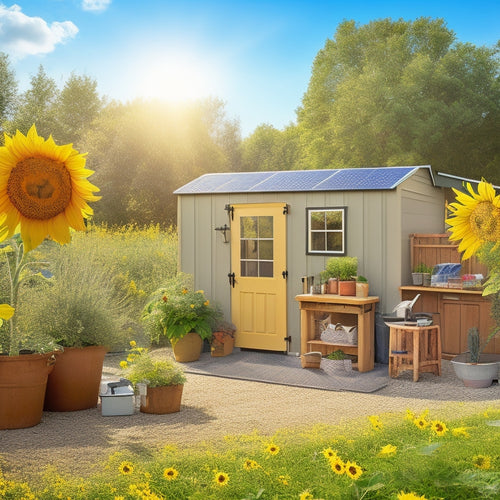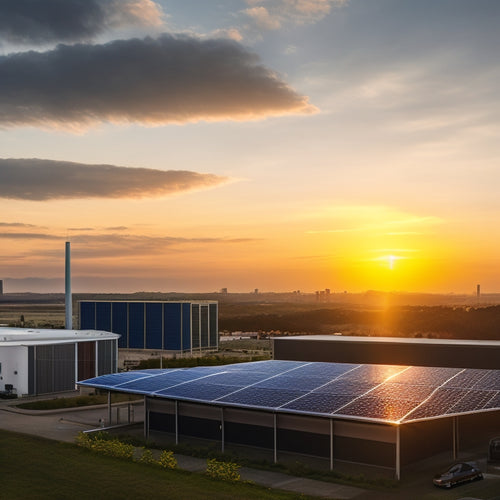
Home Energy Storage Options
Share
You have various home energy storage options available to reduce your reliance on the grid, save on energy bills, and minimize your carbon footprint, but it is crucial to choose the right solution based on your specific power needs and budget. By understanding your daily energy consumption patterns, you can optimize your energy storage system, lowering your monthly bills and environmental impact. From renewable energy integration to battery lifespan factors, there are several aspects to examine when selecting a home energy storage system. As you investigate your options, you'll reveal the ideal solution that suits your energy independence goals and budget, opening up a more sustainable future.
The Essentials
- Home energy storage systems store excess energy generated from solar panels or wind turbines for later use, reducing reliance on the grid.
- Battery types, such as Lead-Acid, Lithium-Ion, and Flow Batteries, offer varying lifespans and warranty periods, influencing energy storage options.
- Assessing daily energy consumption and power usage patterns is crucial for sizing storage systems and optimizing energy efficiency.
- Energy storage systems can be optimized for energy independence, reducing peak demand charges, and minimizing environmental impact.
- Effective energy management through smart technology and load management strategies can reduce energy waste and maximize system benefits.
Reduce Carbon Footprint Easily
When you switch to home energy storage, you'll be going green with ease, reducing your reliance on the grid and minimizing your environmental impact.
By utilizing renewable energy sources like solar power, you'll lower your emission costs and contribute to a cleaner, healthier planet.
With the help of innovations like home solar power battery, you can efficiently store excess energy generated by your solar panels during the day.
Go Green With Ease
In tandem with adopting renewable energy sources, incorporating home energy storage options into your daily life can greatly reduce your carbon footprint. By embracing sustainable solutions, you're taking a significant step towards minimizing your impact on the environment.
With a battery storage system for your solar setup, you can store excess energy generated during the day to use at night or during power outages Energy Storage Solutions, and gain protection from grid outages and fluctuations that can leave you in the dark. Eco-friendly innovations in energy storage have made it easier than ever to shift to a greener lifestyle.
You can start by evaluating your energy needs and identifying areas where you can optimize your energy consumption. Investing in energy-efficient appliances and lighting is a great starting point.
Next, consider integrating solar panels or wind turbines to generate clean energy. Home energy storage systems, such as batteries, can then be used to store excess energy for later use.
Lower Emission Costs
By opting for home energy storage systems, you can considerably lower your emission costs and reduce your carbon footprint with ease. This shift towards renewable energy not only benefits the environment but also provides you with grid independence, energy resilience, and financial incentives. With smart home integration, you can monitor and manage your energy usage, reducing your climate impact.
Here's a breakdown of the benefits:
| Benefits | Description | Impact |
|---|---|---|
| Environmental Benefits | Reduced carbon emissions, sustainable energy source | Lower climate impact |
| Energy Management | Real-time monitoring, smart energy usage | Increased energy resilience |
| Financial Incentives | Government rebates, reduced energy bills | Cost savings |
| Technological Advancements | Efficient battery recycling, improved energy storage | Increased grid independence |
Saves Money on Bills
You can greatly reduce energy expenses by storing excess energy generated by your solar panels or wind turbines during the day for use at night or during power outages.
With a solar battery backup system, such as Tesla Powerwall, you can maximize your savings by optimizing your energy usage.
This approach lowers your monthly costs by reducing your reliance on the grid and minimizing peak-hour charges.
Reduce Energy Expenses
Reducing energy expenses is a top priority for many homeowners, and for good reason - it can save you a significant amount on your utility bills.
By investing in home energy storage, you can optimize your energy efficiency and reap the benefits of cost savings. One way to do this is by storing excess energy generated by your solar panels or wind turbines during the day and using it to power your home at night.
This approach not only reduces your reliance on the grid but also decreases your energy consumption during peak hours, resulting in lower bills. Additionally, energy storage systems can help you avoid peak demand charges, which can account for a significant portion of your energy expenses.
Lower Monthly Costs
Approximately 20% of an average household's energy consumption occurs during peak hours, resulting in higher energy bills. You can greatly reduce these costs by leveraging home energy storage options.
By storing excess energy generated during off-peak hours, you can use it to power your home during peak hours, reducing your reliance on the grid and lowering your energy bills.
Home energy storage systems, such as batteries, enable you to optimize your energy consumption, increasing energy efficiency and generating cost savings.
During the day, your solar panels or wind turbines can generate more energy than you need, which is then stored in the battery for later use. When peak hours arrive, the stored energy is released, reducing your energy consumption from the grid and lowering your bills.
Deep Cycle Battery Life
You're likely wondering how long your deep cycle batteries will last, and what factors affect their lifespan. When it comes to maximizing your renewable energy storage, understanding the lifespan of your batteries is essential, especially when considering solar panel backup and solar power storage solutions Renewable Energy Systems.
The lifespan of your batteries is influenced by several key factors, including the type of battery, depth of discharge, and charging/discharging cycles.
Understanding these factors will help you estimate the cycle life expectancy of your deep cycle batteries and make informed decisions about your home energy storage system.
Battery Lifespan Factors
The lifespan of a deep cycle battery is greatly influenced by several key factors, which can either prolong or shorten its overall lifespan.
When you understand these factors, you'll be better equipped to optimize your battery's performance and extend its lifespan.
Temperature plays a significant role, as high temperatures can accelerate degradation.
You should guarantee your battery is stored in a cool, dry place.
Battery maintenance tips, such as regular cleaning and inspecting, are also vital.
A well-maintained battery will last longer than a neglected one.
Charging strategies also impact your battery's lifespan.
Avoid overcharging or undercharging, as this can cause damage to the cells.
You should aim for a balanced charging strategy that keeps your battery between 20% and 80% state of charge.
Additionally, monitoring your battery's state of health and adjusting your charging strategy accordingly can help prolong its lifespan.
Cycle Life Expectancy
Your deep cycle battery's cycle life expectancy is a critical factor to contemplate when evaluating its overall performance and lifespan. It refers to the number of charging cycles your battery can handle before its capacity degrades.
Different battery technologies have varying cycle life expectancies, with some lasting up to 5,000 cycles or more. You should consider this metric when selecting a battery, as it directly impacts your energy storage system's overall cost-effectiveness.
Proper maintenance practices, such as avoiding extreme temperatures and optimizing charging cycles, can help extend your battery's lifespan. Battery chemistry and energy density also play a significant role in determining cycle life expectancy.
When evaluating performance metrics, look for batteries with high cycle life ratings and efficient thermal management systems. Additionally, consider the environmental impact of your battery choice, including recycling options.
Assess Your Daily Power Needs
You'll need to determine your daily energy consumption to size your home energy storage system correctly.
This requires analyzing your power usage patterns, including the total amount of energy you use daily and when you use it most.
For instance, identifying the times when you rely on backup energy and understanding how renewable energy storage can help you lower your utility bills.
Daily Energy Consumption
Evaluating your daily power needs is essential to determining the right home energy storage solution for your household. To do this, you need to understand your energy habits and consumption trends.
Start by tracking your daily energy usage over a period of time, say a month, to get an accurate representation of your energy requirements. Note the time of day when you use the most energy, and what appliances or devices are contributing to that usage. This will help you identify your peak energy hours and the devices that drive your consumption.
Next, calculate your total daily energy consumption in kilowatt-hours (kWh). You can use your past utility bills to get this information. Knowing your daily energy consumption will help you determine the size of the energy storage system you need.
A smaller system may be suitable if you have low energy needs, while a larger system may be required if you have high energy demands. By understanding your daily energy consumption, you can choose a home energy storage solution that meets your specific needs and provides you with the freedom to manage your energy usage effectively.
Power Usage Patterns
Evaluating daily power needs involves identifying patterns in energy usage to determine the most suitable home energy storage solution. You need to understand your power demand and consumption trends to optimize energy efficiency.
Analyze your daily routine to identify peak usage periods, such as morning and evening when lights, appliances, and HVAC systems are in use. Smart technology can help you monitor and manage your energy consumption, enabling load management strategies to reduce peak demand.
Consider seasonal variations in your energy usage, as heating and cooling requirements change throughout the year. By understanding your power usage patterns, you can size your energy storage system to meet your specific needs, ensuring a reliable and efficient supply of power.
This knowledge will bring you closer to achieving grid independence, where you have control over your energy usage and costs.
Longer Warranty Period Offered
When considering home energy storage options, you'll likely prioritize solutions that provide extended battery life.
A longer warranty period offered by manufacturers can provide you with added assurance, as it typically indicates a higher confidence in the product's reliability and performance.
Extended Battery Life
By opting for home energy storage systems with extended battery life, you're fundamentally investing in a longer warranty period that safeguards your financial commitment. This extended warranty period guarantees you're protected from unexpected battery failures, giving you peace of mind and reducing the need for frequent battery replacements.
| Battery Type | Warranty Period | Depth of Discharge |
|---|---|---|
| Lead-Acid | 5-7 years | 50% |
| Lithium-Ion | 10-15 years | 80% |
| Flow Batteries | 10-15 years | 100% |
Proper battery maintenance is vital to guarantee the longevity of your energy storage system. Regular monitoring and maintenance can help you identify potential issues before they become major problems. Additionally, energy efficiency is imperative in maximizing the benefits of your home energy storage system. By optimizing your energy usage and reducing waste, you can get the most out of your system and enjoy greater freedom from the grid.
Frequently Asked Questions
Can I Install Home Energy Storage Systems Myself?
You can attempt a DIY installation, but it's essential you consider safety concerns, like electrical shock and fire risks, as improper connections can be hazardous, and it's often recommended to hire a licensed professional for a safe and efficient setup.
Are Energy Storage Systems Compatible With All Solar Panels?
When you're on the same wavelength as your solar panel system, you'll find that not all energy storage systems are compatible. Battery chemistry and inverter compatibility are key factors; you'll need to guarantee they're in sync to maximize your energy freedom.
How Often Should I Maintain My Energy Storage System?
To guarantee peak performance, you should maintain your energy storage system regularly, as inconsistent maintenance frequency can negatively impact battery longevity; check your manufacturer's guidelines for recommended schedules to maximize efficiency and extend lifespan.
Can I Use Energy Storage Systems for Backup Power During Outages?
You can use energy storage systems as a battery backup, ensuring outage preparedness and independence from the grid; during outages, your system will automatically switch to backup mode, providing reliable power and freedom from utility disruptions.
Are Energy Storage Systems Eligible for Government Incentives?
As you traverse the complex terrain of renewable energy, you'll find that governments offer enticing carrots, like incentive programs and tax credits, to sweeten the deal; now, you're wondering if energy storage systems qualify, and the answer is yes, if you meet the eligibility criteria.
Final Thoughts
You're likely thinking, "Home energy storage sounds great, but what about the upfront cost?" While it's true that investing in a home energy storage system may require some initial expenditure, think of it as a long-term investment in your wallet and the planet. With the money you'll save on bills and the reduced carbon footprint, it's an investment that'll pay for itself in no time. Plus, with a longer warranty period, you can rest assured that your system will last for years to come.
Related Posts
-

Building an Emergency Backup Solar Power System in 5 Essential Steps
Building an emergency backup solar power system involves five key steps. First, assess your daily energy needs to ide...
-

Top Portable Refrigerators for Camping Adventures
When you're camping, having a reliable portable refrigerator can make all the difference for keeping your food fresh ...
-

Advantages of Commercial Solar Battery On-Site Storage
By investing in a commercial solar battery on-site storage system, you can greatly reduce your energy grid dependence...


